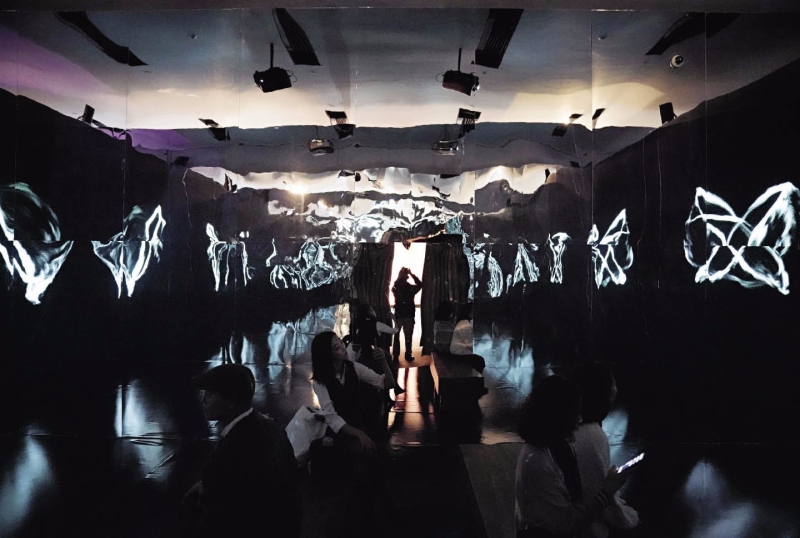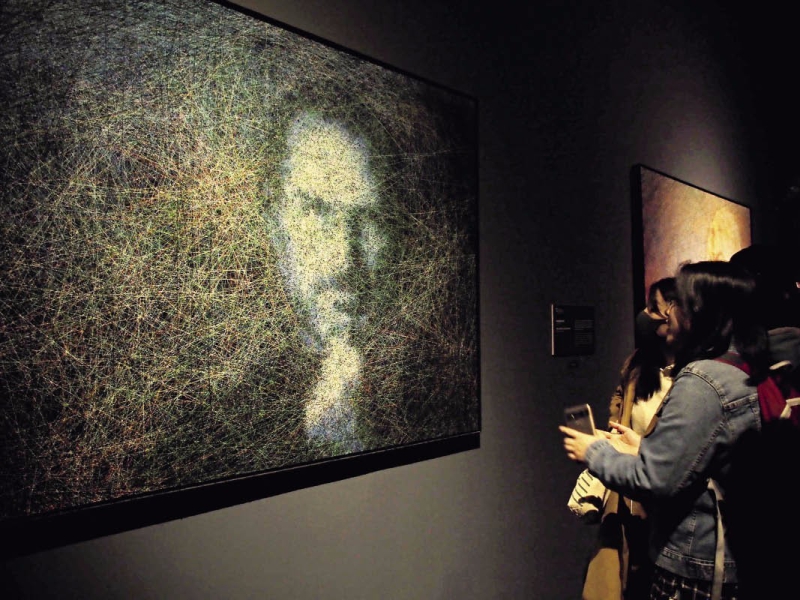The exhibition themed “AS-Helix: the Integration of Art and Science in the Age of Artificial Intelligence” focuses on the cutting-edge achievements in the integration of art and science from all over the world.

The exhibition themed “AS-Helix: the Integration of Art and Science in the Age of Artificial Intelligence” focuses on the cutting-edge achievements in the integration of art and science from all over the world.
Integration Imbues New Charm
During the exhibition, new media art, industrial design, architectural and environmental design, visual communication design, textile and fashion design, ceramic design, and other innovative works reflecting the integration of art and science showcased their distinctive characteristics. Scholars and artists from all over the world combined technological changes to inject continuous inspiration into works of art, interpret the underlying logic and design philosophy of science and art, and showed the in-depth interaction between science and art.
The works of art presented were not only devoted to displaying the real charm brought by the integration of art and science, but also focused on the impetus brought by art and science for the progress of human civilization. A work about the robot Sofia, a platform architecture of AI application, focuses on the application prospects of AI and humanoid simulation robot in daily life; the Brain Computer Interface (BCI) adopts reflective micro-etching technology, and takes the future human brain interconnection as the theme to highlight the amazing advantages and potential dangers of powerful neural interface technology; the immersive new media art work City Memory aroused the audience’s thoughts about the relationship between human beings and science and technology in the future. They are among a series of innovative works with various technologies and rich themes that convey to the public the idea of integration of art and science. The exhibition seemed to pass through the tunnel of time and space, and go to the gate of future technology.
Behind the intelligence craze lies the public’s interest and demand for the development of science and technology and the frontier of art. A college student surnamed Zhao, who is an art lover, talked about her experience of attending the exhibition, “This exhibition is particularly creative, full of scientific and technological elements and artistic beauty, and has constructed a new sensory space integrating light, time, movement, vision, hearing, and touch, which gives me the opportunity to experience a new art form, that is especially impressive.”
“The purpose of holding this exhibition is to systematically display the latest achievements in the frontier exploration of art and science at home and abroad, explore deeply the internal relationship between art and science, continuously promote international innovation of art and science, and promote the harmonious development of art and science,” said Wang Chunfa, director of the National Museum of China.

On November 3, 2019, the Fifth International Art and Science Works Exhibition and Academic Seminar jointly sponsored by Tsinghua University and the National Museum of China opens in Beijing.
Rich Artistic Expressions
Science seeks truth, art seeks beauty. As Tsung Dao Lee, winner of the Nobel Prize in physics, saw art and science as two sides of a coin, he once said that they originate from the most noble part of human activities and both pursue profundity, universality, and eternity.
In the era of AI, the scientific and technological revolution has promoted major technological changes characterized by green technology and intelligence. In this context, how to better realize the deep integration and innovative development of art and science has become a hot topic.
At the symposium held at the time of the exhibition, artists, scientists, designers, and scholars from home and abroad discussed innovations in the AI era, the boundary of machine learning, the role of design in building a sustainable future, and art as the key to AI development in the future. They also talked about deepened human cognition, production mode change, future education, art paradigm design innovation, and sustainable development among other topics.
AI technology has greatly improved the expressiveness and creativity of art and enriched the forms and creation tools of art. The AI application in writing, painting, and music composition, the application of blockchain technology in the field of art, the exploration of design in the field of health engineering, the application possibility of VR technology in medical and equipment manufacturing industries, and the application of computational intelligence in expanding the art world ... Participants held inter-disciplinary discussions on art and science and technology, exchanged case studies on automated creation and open creation, and shared reflections on art innovation and science and technology-driven smart economy. This brainstorm presented immense possibilities for people to create interactive art works in the AI era, and provided solutions for some problems confronting society through the integration of nature, art, design, and science and technology.
At the symposium, nine pieces of art work on the theme of this exhibition received the 2019 Tsinghua University Wu Guanzhong Art and Science Innovation Award. Their common feature is seeking more popular, equal, and shared AI art. A robot, a dynamic sculpture, and an immersive media device are all epitomes of artificial intelligence. Adhering to the design concept of harmonious development of art and science, the design teams strove to enrich the expression and presentation of science and technology through artistic elements, integrate complex scientific and technological concepts into cultural and artistic works, create art with data and artificial intelligence, enrich the cultural connotation of the theme itself with artistic aesthetics, and arouse people’s interest in science with the help of multiple expression methods.
“Artificial intelligence is triggering a chain reaction of scientific breakthroughs, leading to a new round of scientific and technological revolution and industrial reform. It will also accelerate the cultivation of new drivers of economic development and shape a new industrial system, which will have a profound impact on lifestyle and even social structure,” President of Tsinghua University Qiu Yong said.
Humanistic Value
What possibilities does AI bring to artistic and technological innovation? What impact will the integration of art and science have on our life? How to make up for the shortcomings and maximize the benefits of innovative achievements? These are also the areas scholars, scientists, artists, and practitioners think the most and get challenged the most.
Innovative works and practical achievements are emerging in the art and science and technology fields. Although the concepts are constantly being optimized and the applications are gradually expanding, they still face problems and challenges. To this end, Lu Xiaobo, dean of the Academy of Arts and Design of Tsinghua University and vice chairman of China Artists Association, said that contemporary society is undergoing fast development, science and technology continue to advance, new ideas continue to emerge, and art, although more diverse, seems to lose the original common paradigm – the pursuit of beauty, the insistence on the internal power of the noumenon.
The moral and ethical problems brought about by AI are also worth pondering. “AI is more like a muse. It provides a variety of choices and is a tool for human inspiration. Human beings might create new value in the process of cooperation with AI. However, we should also realize that from the perspective of design and technology ethics, AI needs to have responsible innovation and moral responsibility in the future,” said Jeroen Van den Hoven, professor of ethics and technology at Delft University of Technology and editor-in-chief of Springer Nature Publishing Group.
When talking about the role of design in building a sustainable future, Paul Priestman, co-founder and chairman of PriestmanGoode, said that the results of design may solve some problems faced by the earth, such as pollution, an aging population, and traffic congestion.
Many scholars point out a new direction of future exploration: art should not stop, but become more and more powerful in the future through evolution and inheritance. In this process, humanistic value is particularly important. Art and design drive innovation with scientific spirit and humanistic feelings.
Nowadays, culture and art are constantly changing with the development of science and technology. At the same time of protecting history and culture, inheriting the classics of the times and carrying forward diverse cultures, people expect more diversified artistic expression forms. Undoubtedly, the integration of science and art will bring more possibilities.
___________
ZHAO TINGYU is a staff member of China International Publishing Group Training Center.